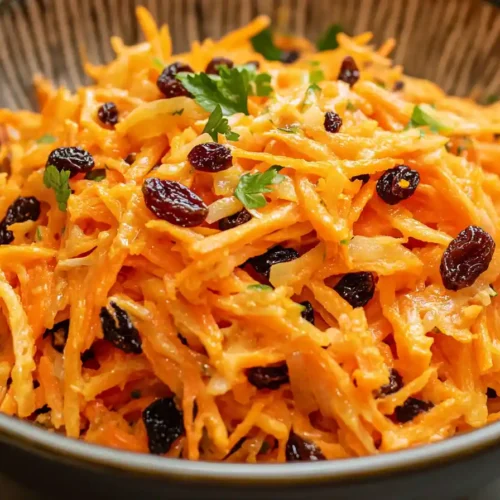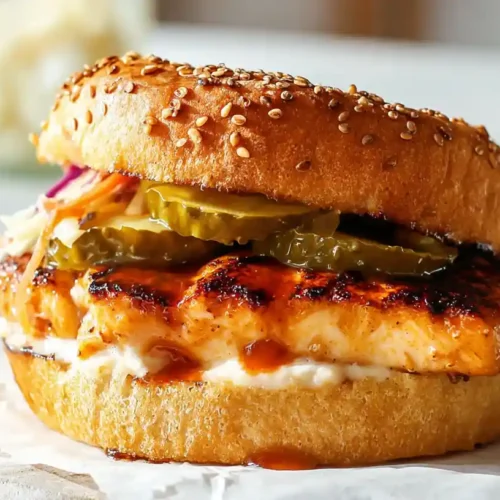This pineapple upside-down cake is pure comfort—soft, buttery, and topped with caramelized brown sugar, pineapple rings, and bright maraschino cherries. As it bakes, the fruit juices slowly sink into the cake, making every bite rich, moist, and packed with nostalgic flavor. Made with pantry staples and canned fruit, it’s the kind of classic that feels just right year-round.
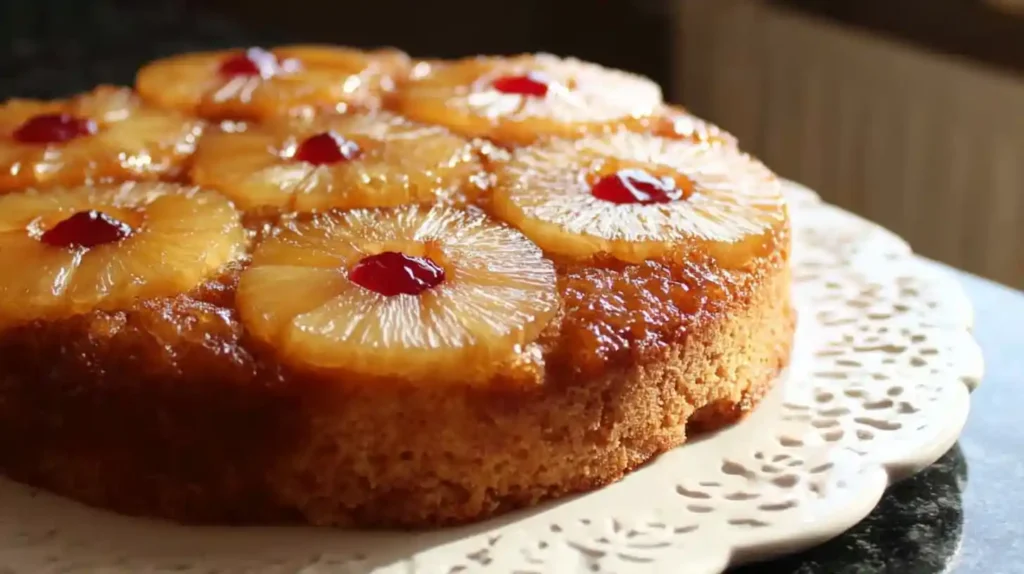
Truthfully? This one’s personal. I’ve spent a lot of time refining it—testing textures, adjusting ratios, figuring out exactly what makes a pineapple upside-down cake not just good, but crave-worthy. And today, I get to share that with you. Let’s make it count.
For more recipes, check the Strawberry Cheesecake Dump Cake Recipe
Table of contents
Essential Ingredients for the Perfect Pineapple Upside-Down Cake
Okay, pause before you start pulling stuff out of your pantry, there’s something you should know: pineapple upside-down cake is weirdly unforgiving for how charming it looks. The ingredients are simple, yes, but each one matters. A swap here or a shortcut there, and suddenly your cake turns into a soggy fruit pancake. Let’s not.
Topping Essentials: This Is Where the Drama Happens
- ¼ cup unsalted butter, melted
This is your caramel base. Don’t go rogue with margarine—it won’t set the same way. - ½ cup packed light brown sugar
The brown sugar melts into a rich, syrupy blanket. Want more depth? You could use dark brown sugar, but that leans into molasses territory. - 1 can (20 oz) pineapple rings in juice
Use the juice-packed kind, not syrup. And dry them off—seriously. Nobody likes a cake with wet feet. - 15–20 maraschino cherries
Optional? Technically. But let’s be honest—without those neon cherries, is it even pineapple upside-down cake?
The Vanilla Cake: Light, But Not Flimsy
- 1½ cups cake flour
Not all flour is equal. Cake flour keeps the crumb soft, not heavy like all-purpose. - 1 tsp baking powder + ¼ tsp baking soda
The rise team. They work together to lift but not puff. - ½ tsp salt
Think of this as your flavor amplifier. - 6 Tbsp unsalted butter, softened
Cream it with sugar to trap air and get that light, dreamy texture. - ¾ cup granulated sugar
Just enough to sweeten without making things cloying. - 2 large egg whites
No yolks here—just the protein boost for structure and lift. - ⅓ cup sour cream
Adds moisture and a bit of tang that cuts the sweetness perfectly. - 1 tsp vanilla extract
Because plain cake is sad cake. - ¼ cup pineapple juice (from the can)
Why waste it? Adds flavor and a nod to what’s on top. - 2 Tbsp milk
Just a splash to loosen the batter. You’ll know if you need it.
Gear You’ll Be Glad You Have
- 9×2-inch round pan – Not 8-inch. Not shallow. Trust me.
- Electric mixer – Can you cream butter by hand? Sure. Should you? Probably not.
- Mixing bowls – Two at minimum. No shortcuts here.
- Cooling rack + baking sheet – You’ll thank yourself when flipping and catching rogue drips.
Can I use fresh pineapple instead of canned?
You can. But here’s the thing: fresh pineapple is juicier, sometimes too juicy. It also varies wildly in size. If you’re going this route, slice it thin and blot it dry, like, aggressively. Canned is easier and, let’s be honest, the look is iconic.
How to Make Pineapple Upside-Down Cake Step-by-Step
Alright. You’re here for results, not a Pinterest fail. So let’s go through this in a way that feels like a friend walking you through it, minus the vague instructions and overly confident tone that never works when your pan starts leaking caramel.
1. Start with the Topping (It Sets the Stage—Literally)
- Pour melted butter directly into an ungreased 9×2″ round cake pan. No need to swirl, just tilt it gently until the bottom’s coated.
- Sprinkle brown sugar evenly. It might clump a little—don’t stress. Spread it gently with your fingers if needed.
- Arrange your pineapple rings—center first, then halves along the perimeter. This is the part where symmetry feels weirdly important.
- Drop a maraschino cherry into each ring and between the gaps. Or don’t. But if you skip them, your cake will taste great and still somehow feel incomplete.
- Now… here’s the move almost nobody tells you: stick the pan in the fridge for 15–20 minutes. You want that butter to solidify a bit. Otherwise, your pretty toppings might do the electric slide during baking.
2. Batter Time (Texture Lives Here)
- Whisk together cake flour, baking powder, baking soda, and salt in one bowl. Nothing fancy yet—just dry stuff meeting dry stuff.
- In another bowl, cream butter and sugar until fluffy. Like, “Wow, this feels luxurious,” fluffy.
- Add your egg whites, one at a time. The mix might look separated—that’s fine. It’ll come back together.
- Fold in sour cream and vanilla extract. It should start looking like the batter version of a thick milkshake.
- Add the dry mixture alternating with the pineapple juice and milk. Go in stages: dry-wet-dry-wet. Stir just until it’s blended. Stop yourself from overmixing. Really.
3. Build & Bake (Now It Feels Real)
- Pull your chilled pan from the fridge. If the sugar-butter base looks a bit solid? Perfect.
- Spoon the batter on top of the fruit layer gently. This is like putting a sheet over a sleeping baby—you don’t want to wake the pattern underneath.
- Smooth the top with a spatula.
- Bake at 350°F (177°C) for 43–48 minutes. Halfway through, check if the top’s browning too fast—tent it loosely with foil if needed.
- Slide a baking sheet under the pan (or on the rack below) to catch any drips. Trust me on this one.
4. The Flip (The Moment of Truth)
- Once out of the oven, let it cool in the pan for 20 minutes. Not 10, not 40. Twenty. That’s your window.
- Run a knife around the edge. Place a serving plate on top, take a breath, and flip confidently. Or awkwardly. Either works.
- Tap the pan gently if the cake resists. It usually doesn’t.
5. Let It Set (Or Regret It)
- This cake looks best once fully cooled. If you slice too soon, gravity will do its thing and you’ll have pineapple puddles. Wait for it to firm up—you’ll get cleaner slices and better structure.
What if some pineapple or cherries stick to the pan?
Don’t panic. Just lift them off and patch your cake like it’s no big deal—because honestly, it isn’t. A “perfect” top is overrated. That patchwork slice might even be the tastiest one.
Tips & Tricks for a Pineapple Upside-Down Cake That Doesn’t Betray You
Have you ever baked something, followed the recipe to the letter, and still ended up wondering, “Why does mine look like a before photo?” Yeah. That’s why this section exists. These aren’t just tips—they’re rescue lines, learned either the hard way or from quietly lurking baking forums at 1 a.m.
Fruit Tactics: Blot or Regret It
- Blot your pineapple slices. Like, press them between paper towels. Twice. Canned fruit is soaked in juice, and while that’s great for flavor, it’s a sabotage move for texture.
- Same goes for maraschino cherries. They’re sugar sponges. A quick blot keeps them from bleeding red halos into your batter.
Butter Behavior: Chill = Control
- After layering the topping, chill your pan. This small step keeps everything in place and prevents the dreaded floating ring syndrome. Yes, that’s a thing.
Don’t Overmix the Batter (I Know It’s Tempting)
- Once the dry meets the wet, mix until just combined. Overmixing activates gluten, which turns your tender cake into a chewy bread impersonator. That’s not the vibe.
Tent If You Must
- About halfway through baking, check the top. If it’s browning faster than the middle is baking, gently lay foil over it, like a loose little hat. Don’t crimp it down—you’re not sealing leftovers.
Cool Down: You’ve Got Time
- Let the cake sit in the pan for exactly 20 minutes before flipping. Wait longer, and it might stick. Flip too soon and you’ve got a lava slide of caramelized chaos.
- After flipping, walk away. Seriously. Let it cool fully before cutting. The topping needs to firm up, and the crumb needs to settle. If you slice too soon, it’ll fall apart—and you’ll blame the recipe, not your impatience.
My cake came out dense—what went wrong?
Probably one of three things:
- You used all-purpose flour instead of cake flour (easy to miss).
- You overmixed the batter.
- You didn’t cream the butter and sugar long enough to trap enough air.
Remember, dense isn’t always bad with this cake—but it should still feel soft and slice cleanly, not like pineapple bread pudding.
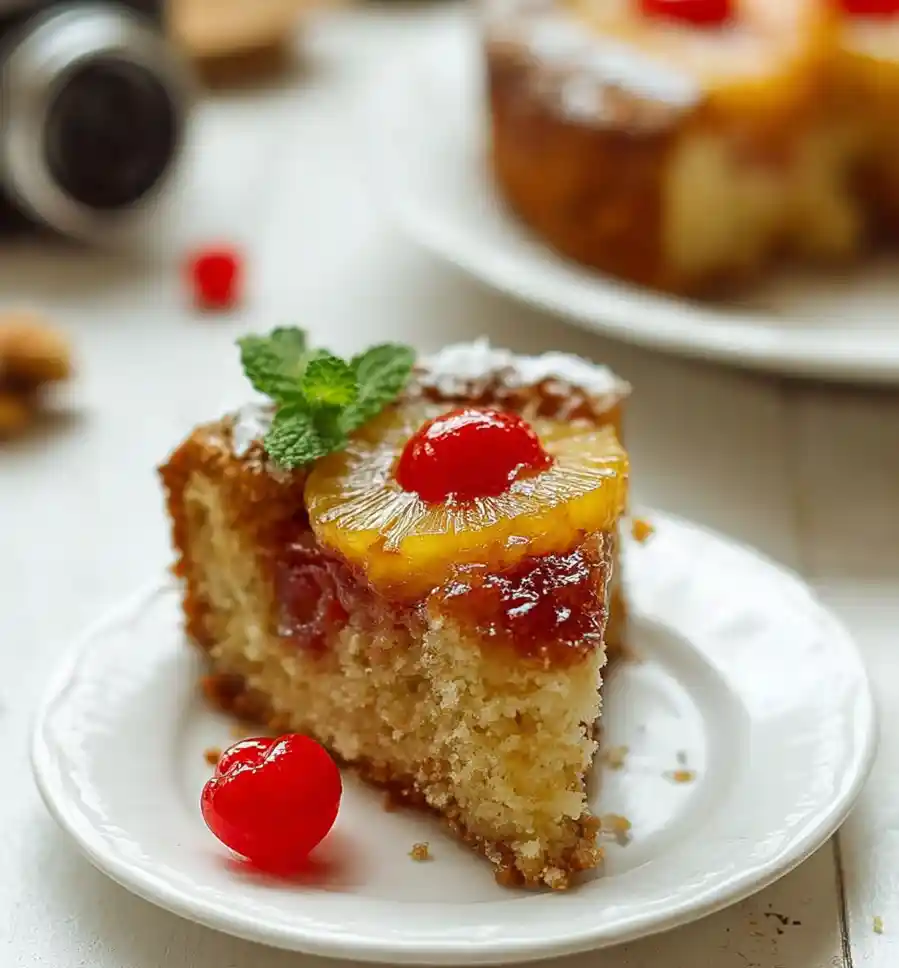
Ingredient Swaps for Pineapple Upside-Down Cake Variations
Look, sometimes you’re halfway through preheating the oven before realizing you’re out of sour cream, or you’re baking for a friend who can’t eat eggs, or you hate those neon cherries. It happens. Baking’s supposed to bend a little. But not all substitutions are created equal—some give you a solid “close enough,” others wreck the whole vibe. Let’s sort them out.
If You’re Out of Cake Flour
Honestly, it happens more than people admit. Cake flour isn’t a pantry staple for everyone. You can get close with this trick:
- Measure 1½ cups all-purpose flour
- Remove 3 tablespoons
- Add 3 tablespoons of cornstarch
- Then sift it. Twice.
Will it be the same? Not exactly. But unless you’re entering a baking competition judged by Paul Hollywood, you’ll survive.
Gluten-Free? Possible, But…
A decent 1:1 gluten-free blend (like Cup4Cup or King Arthur’s) can work, but fair warning: the texture shifts. Expect a bit more crumble, slightly less lift. You’ll also want to handle the batter gently and avoid overmixing. That’s where most GF disasters begin.
Egg Replacements: Let’s Talk Texture
No eggs? You’ve got options:
- ¼ cup unsweetened applesauce
- ¼ cup plain Greek yogurt
Both mimic moisture, not structure. So yes, the cake will bake. It’ll taste fine. But expect a denser, more muffin-like crumb. If you’re okay with that? Cool. If you’re going for picture-perfect slices… maybe borrow two eggs from the neighbor.
Hate Maraschino Cherries?
Valid. They’re divisive—some people love the nostalgia, others can’t get past the candied vibe.
Try this instead:
- Halved raspberries (juicy but pretty)
- Blueberries (tighter hold)
- Or… skip them. The pineapples can carry the drama solo.
Fresh vs. Canned Pineapple: A Philosophical Debate
Fresh pineapple looks great on paper, but here’s the deal: it’s unpredictable. Juicier. Fibrous. Thicker. If you slice it thin, blot it thoroughly, and have the patience of a saint? Sure, go for it. But if you want predictable caramel magic, canned in juice is your safest bet.
No Dairy? You’ve Got Options
- Sour cream swap: Go with a thick, tangy dairy-free yogurt—coconut or oat-based work best.
- Butter backup: A vegan baking stick (not a tub spread) like Earth Balance can do the job. Just know: the flavor might shift slightly. And whatever you do, skip margarine. It melts like hope in a hot car.
What if I only have a bundt pan?
I mean… technically? Yes. But be prepared to lose half your fruit to the pan gods. Upside-down cakes need a flat stage to show off their toppings. Bundts are deep and curvy—great for pound cakes, not so much for pineapple drama. Stick with a 9×2” round unless you’re feeling bold or reckless.
Conclusion
You know what’s kind of refreshing about pineapple upside-down cake? It doesn’t fake sophistication. It’s not trying to reinvent itself or win points for plating. It’s just sweet, sticky nostalgia served warm, with a cherry in the middle and a bit of caramel that always ends up on your thumb.
And maybe that’s exactly why it endures.
This version trims the chaos—no soggy base, no sliding fruit, no “why is my cake raw in the middle?” moments. It respects the original without being trapped by it. Just small upgrades. A steadier crumb. A cleaner flip. Less guessing, more baking confidence.
If it’s your first time, great. If it’s your twentieth, even better. Because no matter how many times you make it, that flip? Still kind of thrilling. Still worth the nerves.
And if it breaks a little? Honestly… that’s kind of the point.
FAQs
What is a pineapple upside-down cake, exactly?
Honestly? It’s part dessert, part drama. You build it backwards—fruit and sugar go down first, then batter, then the whole thing gets flipped after baking so the fruit ends up on top. It’s like a little culinary magic trick that somehow always gets applause, even when it comes out a little lopsided. People started making it in the early 1900s when canned goods hit big. The format stuck because… it just works. It’s warm, sticky, and unapologetically sweet.
Should I flip it while it’s hot or cold?
Neither. Warm is your golden zone. About 20 minutes post-bake. Too soon and it collapses like a deflated soufflé. Too late, and it clings to the pan like its life depends on it. It’s that awkward “not hot, not cold” middle where the caramel loosens but the cake’s still intact. I know it sounds fussy, but set a timer. You’ll thank yourself.
What cake mix works if I’m not doing this from scratch?
If you’re box-mixing it (and hey, no shade), go with a yellow cake mix—moist, mellow, dependable. Butter golden works too if you want a bit more richness. Just one heads-up: cut back slightly on any added liquid. Pineapple adds its moisture, and if your batter’s too thin, you’ll end up with a pudding layer under the cake. Not the vibe.
Any tricks to flipping it without wrecking everything?
Yes. And no. It’s part technique, part faith.
- Cool it for 20 minutes. Not 10, not an hour.
- Run a thin knife along the edges—carefully.
- Place a larger plate over the pan, grip both, and flip in one fluid motion. Don’t overthink it.
- Let the pan sit upside-down on the plate for a few beats—gravity is your friend here.
- Then lift, slowly.
If a pineapple or cherry sticks? Reassign it. No one will know. And if they do? Call it rustic and move on.
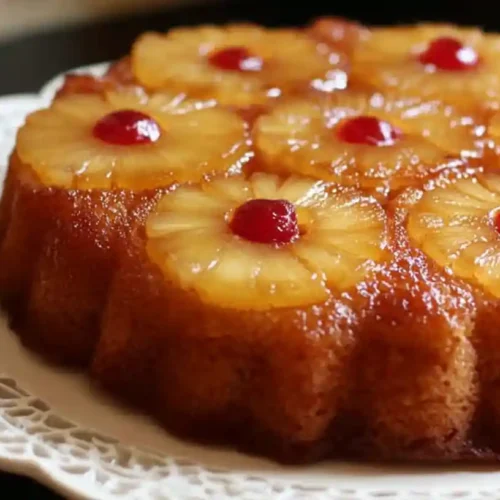
Pineapple Upside-Down Cake
Equipment
- 9×2-inch round cake pan
- Mixing bowls
- electric mixer
- cooling rack
- Baking sheet
Ingredients
Topping
- 1/4 cup unsalted butter melted
- 1/2 cup light brown sugar packed
- 8–10 rings canned pineapple blotted dry
- 15–20 maraschino cherries blotted dry
Cake
- 1 1/2 cups cake flour
- 1 tsp baking powder
- 1/4 tsp baking soda
- 1/2 tsp salt
- 6 Tbsp unsalted butter softened
- 3/4 cup granulated sugar
- 2 large egg whites
- 1/3 cup sour cream room temperature
- 1 tsp vanilla extract
- 1/4 cup pineapple juice from can
- 2 Tbsp milk room temperature
Instructions
- Preheat oven to 350°F (177°C). Pour melted butter into bottom of ungreased 9×2-inch pan. Sprinkle with brown sugar. Arrange pineapple and cherries. Chill 15–20 minutes.
- Whisk flour, baking powder, baking soda, and salt in a medium bowl. Set aside.
- In a large bowl, cream softened butter and sugar until fluffy. Mix in egg whites, then sour cream and vanilla.
- Add dry ingredients in batches, alternating with pineapple juice and milk. Stir just until combined.
- Pour batter into chilled pan over the fruit layer. Smooth the top. Bake 43–48 minutes. Tent with foil if browning too fast.
- Cool in pan 20 minutes. Run knife around edge, place serving plate on top, and invert. Let cool fully before slicing.
Notes
Follow me on Pinterest for more delicious recipes and culinary inspiration—your best sources for tasty, shareable food ideas!

